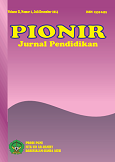STRATEGI MEMBANGUN KOMUNIKASI YANG EFEKTIF UNTUK MENINGKATKAN KINERJA GURU DI SEKOLAH
DOI:
https://doi.org/10.22373/pjp.v10i2.10290Keywords:
Strategy, Communication, Teacher PerformanceAbstract
This article aims to reveal: (1) the nature of communication in the perspective of the Qur'an, (2) the meaning of communication in organizations according to experts, (3) the nature and benefits of effective communication for school/madrasah principals, (4) indicators of effective communication in school/madrasah, (5) the nature of teacher performance in school, (6) the principal's strategy to build effective communication to improve teacher performance in school/madrasah.
References
Argiris C., 1994. Good communication that block learning. HBR. July - Agustus
Binti. Nasukah, dkk. (2020). peran Komunikasi Efektif Pemimpin Dalam Meningkatkan Kinerja Institusi. Al-Tanzim: Jurnal Manajemen Pendidikan Islam, 4 (1): 81-93
Dawn. E., & Tyler. ED (2016). Perilaku Komunikasi Kepala Sekolah di Sekolah Dasar Judul Berkinerja Tinggi I di Virginia: Pemimpin Sekolah, Komunikasi, dan Upaya Transformatif. Jurnal Kepemimpinan Interdisipliner Creighton, 2, 2-16.
https://doi.org/10.17062/cjil.v2i2.51
Fashiku, CO (2017). Komunikasi Efektif: Peran Apa pun dalam Proses Belajar Mengajar di Kelas di Sekolah Nigeria. Bulgarian Journal of Science & Education Policy (BJSEP), 11, 171-187.
Griffith, D.A., 2002. The role of communicayion competencies in international business relationship development. Journal of World Business, 37 (4), 256- 265.
Hasbiansyah.O, (2015:1). Efective Communication. https://www.unisba.ac.id/effective-communication/. diakses tanggal 14 Mei 2021
Hassa. Nurrohim. dan Anatan Lina. (2009), Efektivitas Komunikasi Dalam Organisasi. Fakultas Ekonomi Universitas Pembangunan Nasional Veteran Yogyakarta, dan Fakultas Ekonomi Universitas Kristen Maranatha Bandung, Jurnal Manajemen 7, 3
Herlina. Husein. (2017). Metode Ta’dib dan Komunikasi Islami Menurut Perspektif Al-Qur’an dan Hadist dalam Pembangunan Karakter Anak Usia Dini. Golden Age 1 (1): 47
https://id.wikipedia.org/wiki/, (2021). Komunikasi_efektif. Wikipedia bahasa Indonesia, ensiklopedia bebas. diakses tgl. 15 Mei 2021
Ibrahim, A., & Mahmoud, S. (2003). Gaya Komunikasi Kepala Sekolah dan Kinerja Sekolah di Sekolah Pemerintah. Al Ain, UEA. Jurnal Internasional Studi Penelitian dalam Pendidikan, 6, 29-46. https:// doi. Org /10. 5861/ ijrse. 2016.
Jasmani, Asf & Syaiful Mustofa. (2013). Terobosan Baru dalam Kinerja Peningkatan Kerja Pengawas Sekolah dan Guru. Jogjakarta: Ar-Ruzz Media.
Mesiono. (2019). Islam dan Manajemen. Medan: Perdana Publishing.
Mubasyaroh. (2017). Strategi Dakwah Persuasif dalam Mengubah Perilaku Masyarakat. Ilmu Dakwah: Academic Journal for Homiletic Studies, 11(2), 311–324.
Nwosu. JC (2017). Strategi Komunikasi Kepala Sekolah dan Prestasi Kerja Guru di Sekolah Menengah Umum di Wilayah Pemerintah Daerah Ikenne, Negara Bagian Ogun. Jurnal Internasional Pendidikan, Pembelajaran dan Pengembangan, 5, 1-12.
Rakhmat Jalaluddin. (1993). Psikologi Komunikasi. Bandung: PT. Remaja Rosdakarya
Rokhmah, Noor Ariyani. Anggorowati (2017). Komunikasi Efektif Dalam Praktek Kolaborasi Interprofesi Sebagai Upaya Meningkatkan Kualitas Pelayanan, Universitas Diponegoro Semarang Indonesia. Journal of Health Studies, 1, (1), 65-71
Sezgin, F. (2016). Persepsi Guru tentang Gaya Komunikasi Interpersonal Kepala Sekolah: Studi Kualitatif di Sekolah Dasar Turki. Jurnal Ilmu Pendidikan Online Internasional. 8, 10-19
Suci, Hartati Aseh, (2019). Komunikasi yang Efektif dalam Organisasi. Universitas Negeri Padang
Suryanto Adi dkk. (2019), Komunikasi Yang Efektif, Modul Diklat Kepemimpinan Administrator. Edisi 2019. Jakarta: Lembaga Administrasi Negara.
Syam, A. R. (2017). Konsep Kepemimpinan Bermutu dalam Pendidikan Islam. Jurnal Al-Ta’dib, 12 (2), 49–69.
Wahjosumidjo. (2011). Kepemimpinan Kepala Sekolah Tinjauan Teoretik dan Permasalahannya. Jakarta: PT. Raja Grafindo Persada.
Yusuf, BM dkk. (2014). Kajian tentang Hambatan Komunikasi Lintas Budaya pada Perusahaan Berbasis Elektronik. Jurnal Internasional Ilmu Sosial, 27, 187-196.
Downloads
Published
Issue
Section
License
- Authors retain copyright and grant the journal right of first publication with the work simultaneously licensed under a Creative Commons Attribution License that allows others to share the work with an acknowledgment of the work's authorship and initial publication in this journal.
- Authors are able to enter into separate, additional contractual arrangements for the non-exclusive distribution of the journal's published version of the work (e.g., post it to an institutional repository or publish it in a book), with an acknowledgment of its initial publication in this journal.
- Authors are permitted and encouraged to post their work online (e.g., in institutional repositories or on their website) prior to and during the submission process, as it can lead to productive exchanges, as well as earlier and greater citation of published work (See The Effect of Open Access).

